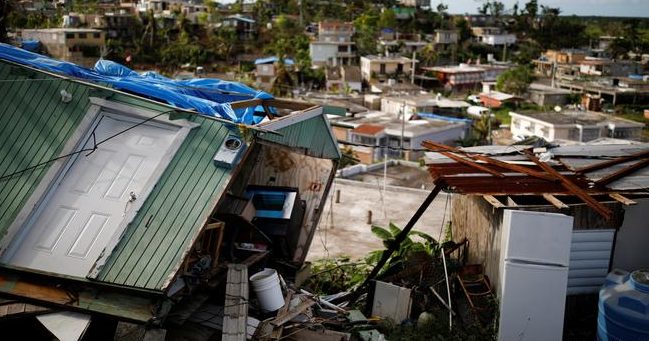Officials in Puerto Rico now say 2,975 people died following Hurricane Maria – a devastating storm that struck the US island territory in September 2017.
The revised death toll is nearly 50 times the previous estimate of 64.
Governor Ricardo Rossello “accepted” the findings in a long-awaited independent investigation.
Puerto Rico has struggled to repair its infrastructure and power grid since the storm, and is asking US Congress for $139bn (£108bn) in recovery funds.
“I’m giving an order to update the official number of deaths to 2,975,” Governor Ricardo Rossello said at a press conference on Tuesday.
“Although this is an estimate, it has a scientific basis,” he said.
In a statement, the White House said the federal government supported the governor’s efforts to “ensure a full accountability and transparency of fatalities” in last year’s hurricane.
President Donald Trump was criticised for praising the federal response to the hurricane-ravaged island in the weeks following the storm.
Critics accused him of showing more concern for residents in Texas and Florida after they were hit by hurricanes.
The authorities have faced nearly a year of criticism for underreporting the true toll of Maria – the most powerful storm to hit the region in nearly 90 years.
Until now, the official figure was 64 – even though the island had previously acknowledged the death toll was probably much higher.
In the wake of the disaster, some experts estimated as many as 4,600 deaths.
The government’s initial number was arrived at by counting those crushed by collapsing structures, drowned and hit by flying debris.
The latest findings – accepted by the island’s authorities – were made in a report by experts from George Washington University, which the governor commissioned.
“This shows the magnitude of the catastrophe,” Governor Rossello told newspaper El Nuevo Dia.
When asked why his government was unable to recognise a higher death toll, he replied: “I am not perfect. I make mistakes. Now, hindsight tends to be 20-20.”
He echoed one finding in the report – that doctors “lacked awareness” on how to appropriately certify deaths attributed to natural disasters.
“The responsibility for adjudicating the cause of deaths rested with the doctors,” Mr. Rossello told the island’s most circulated paper. “But unfortunately there was no formal process to prepare them for this kind of devastation.
“At that moment, that was the number [of deceased] that we had and today we have the evidence which indicates the number was definitely higher.”
Researchers tracked the number of deaths using death certificates and other mortality data between mid-September 2017 to mid-February of this year.
Many people died as a result of poor healthcare provision and a lack of electricity and clean water.
Repeated power outages also led to an increased number of deaths from diabetes and sepsis.
The Caribbean island is home to 3.3 million US citizens, some 8% of which have since left the island, the study said.
It also said that those from poorer backgrounds in Puerto Rico were 45% more likely to have been killed in the aftermath of the hurricane.
The governor said he would sign an executive order to create a committee to examine and put into practice the report’s recommendations.
Puerto Rico has been reeling ever since this devastating storm hit its shores – with residents still suffering blackouts, broken infrastructure and a lack of services.
Hurricane Maria caused the largest blackout in US history, according to research consultancy the Rhodium Group.
It is ranked as the third most financially costly cyclone in US history since 1900, yet its death toll is a third higher than the costliest – Hurricane Katrina in 2005, with an estimated 1,833.
Hong Kong woman marries stranger after being ‘tricked’ by work
A 21-year-old Hong Kong woman has said she was tricked into marrying a complete stranger on the mainland while taking part in a “mock” wedding.
The woman has said she was told that she had to play the role of a bride in a simulated wedding as part of her training to be a wedding planner.
During the ceremony she and the man signed a genuine marriage document.
She only realised she was actually married after returning to Hong Kong, where she sought legal help.
Local police were unable to help due to a lack of evidence that a crime had taken place, so she approached the Hong Kong Federation of Trade Unions (FTU).
“It’s a new form of marriage scam,” Tong Kamgyiu, director of the Rights and Benefits Committee of FTU, told the BBC.
“I feel disappointed and cannot believe it’s even happening in modern Hong Kong.”
In May, the 21-year-old – who has not been named – saw a listing on Facebook for a make-up artist apprenticeship.
But after applying, she was convinced by the firm to switch to a wedding planner role.
She was given a week’s worth of free training in Hong Kong and was told she needed to participate in a mock wedding in the Chinese province of Fuzhou to pass the course.
In July, she signed a marriage application document in a local government centre.
According to the South China Morning Post, the company told her the marriage would be “void” afterwards.
But after coming back to Hong Kong, one of her classmates convinced her that it was a scam.
She remains married for now and may have to apply for a divorce.
It is unclear who the man she married is, or if he entered Hong Kong after the marriage.
“The 21 year-old lady was taken advantage of while she knew nothing about the circumstances,” said Mr Tong.
“Her biggest loss is to have a marriage record and it has caused her psychological damage.”
Each year, Hong Kong police see an average of 1000 cross-border marriage scam cases.
Chinese residents who are married to a Hong Kong partner are able to apply to reside in the city.
READ ALSO: Theresa May’s visit: Don’t be hoodwinked into endorsing Buhari –PDP
Morocco: Arrests made in Khadija rape and torture case

Police in Morocco have arrested 12 young men over allegations by a 17-year-old woman that she was brutally raped and tortured over a two-month period.
She described in a TV interview last week how she was abducted by a gang in June.
“I will never forgive them – they have destroyed me,” she said.
The case caused outrage in Morocco and led to an online campaign to bring those responsible to justice.
A judge-led investigation is under way in the city of Beni Mellal – those arrested are aged between 18 and 27, an official told the AFP news agency.
The main suspect, 20, faces charges of rape, torture, kidnapping, making death threats and forming a gang.
The others could face similar charges.
The young woman, Khadija, appeared on Moroccan station Chouf TV last week.
She showed scars, cigarette burns and tattoos on her body, which she said were inflicted on her by her captors.
“I tried to escape several times, but I was caught and beaten,” she said. “They tortured me, they did not give me food or drink, and they did not even allow me to take a shower.”
In response to the TV interview, thousands have signed an online petition calling for help for Khadija and the hashtag #JusticePourKhadija has become popular.
But there has been a backlash too as relatives of the suspects have accused Ms Okkarou of lying in Moroccan media, accusing her of living a “depraved” lifestyle.
Many women in Morocco are the victims of violence in a deeply conservative society, human rights groups say.
More than 20% of Moroccan women have been sexually abused at least once in their lives, Morocco’s National Human Rights Council reported in 2015.
In 2014, an article of the penal code allowing rapists of underage girls to avoid prosecution by marrying their victims was amended by Morocco’s parliament.
China moves to end two-child limit, finishing decades of family planning
The Chinese government could be moving to end birth restrictions, amid growing concerns over an aging population and a dropping birth rate.
Under current family planning rules, the majority of Chinese couples are limited to two children, following an easing of the country’s notorious “one-child policy” in 2016.
These restrictions now look set to be further relaxed under a new draft reform to the country’s Civil Code, potentially allowing families to have multiple children for the first time in decades.
According to a brief statement released Tuesday by the National People’s Congress, the new revised code “will no longer retain the relevant content of family planning.”
The revised code won’t be completed until March 2020 and there is no indication yet how exactly the change would be made, or whether any other restrictions or conditions might remain on Chinese families.
But a change to the country’s strict family planning laws had been considered likely by experts for some time.
“The government will lift the policy, to what degree they then go further with pre-natal policy is another issue, but I think they’ll lift the policy in the foreseeable future,” Therese Hesketh, professor at the University College London’s Institute for Global Health, told CNN.
Worries over a falling birth rate had led Beijing to announce in October 2015 it would no longer mandate Chinese couples only had one child, ending policy that for decades has been blamed for infanticide and forced sterilizations.
Instead, parents were allowed and even encouraged to have up to two children.
An opinion piece titled “Giving birth is a family matter and a national issue” was published on August 6 in the overseas edition of People’s Daily, mouthpiece of the ruling Chinese Communist Party.
But the changes failed to produce a spike in the birth rate.
In 2017, the country’s total fertility rate was 1.6 children per woman, well below the 2.1 rate estimated to be necessary to keep the population steady.
“Relaxing the One Child policy actually didn’t lead to an immediate jump in births, which the government was kind of predicting and counting on,” Human Rights Watch senior researcher Maya Wang told CNN.
“So now the Chinese government has come around to the opinion as well they need to further relax their control and abolish the birth controls altogether.”
CNN contacted China’s National Health Commission, which oversees the country’s family planning, for comment on the story.
The Chinese government is concerned it could soon be running out of workers as the effects of the country’s long-standing One Child policy begin to hit home.
The infamous policy was originally introduced in 1979 over concerns by the Communist Party leadership that the population would soon spiral out of control.
However several decades on, the family planning policy has left a shrinking pool of young people left to support their aging parents and grandparents.
“Especially in cities, the cost of having children is getting higher and higher. From birth to school, economic costs and time costs are rising,” said the People’s Daily opinion piece in August. “Many young people living in cities are not willing to have children.”











